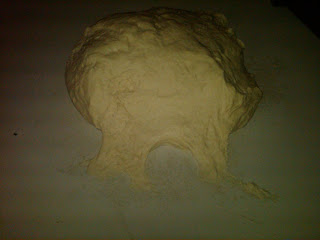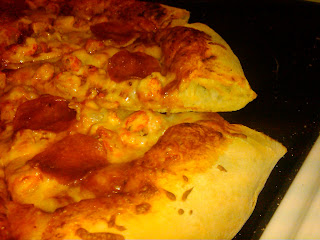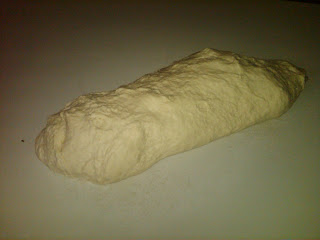Let me begin by saying that this particular blog is not only about the crust, it's ALL about the crust. For my research thus far I have not cared one iota about the toppings. In fact during my crust recipe development I have sought to create a New York Style Pepperoni Pizza and have bought only the cheapest mozzarella and pepperoni possible because my endeavor at this point is only about the crust.
And this is not about Neapolitan Pizza Crust, that is a whole different animal. This is about greasy, fold in half, pizza like you get on the streets of New York.
NOTE on Neopolitan Pizza.- There is a recomendation online by a renowned "Neopolitan" pizza maker to cut the locking lever on your oven door to be able to use the high temp of your oven's cleaning cycle to make Neopolitan pizzas. DO NOT do this. I do not think it is dangerous, it might even work, but it just seems a bit extreme to me.
Having made that level set...we need to make another one. This one will be hard for some to swallow, NO RECIPE WORKS IN AND OF ITSELF. There I said it. This is the long held secret of all great culinary authors and their publishers. This is what they don't want you to know. They want you to think that all you need to do is follow the recipe and you will be an award winning chef. Nonsense.
OK, yeah there are simple recipes that you can follow and end up with what you expected. But what I am referring to are those recipes that no matter how hard we try, we simply can't seem to duplicate what the author intended. Those recipe books with beautiful pictures of dishes that simply make your mouth water.
Recipes of baked goods and breads are especially hard to duplicate. The belief that you can "follow" a recipe and come out with "EXACTLY" what the picture looks like is naive. To think that if I just measure more accurately, or if I just follow the recipe more accurately I will end up with what I see in the picture is bullshit. Recipes aren't maps that lead you to a particular destination. What they are is one persons attempt to document the road they traveled. And trust me when I say, the road you are trying to navigate in your kitchen, is in a whole different country than the one they were on in theirs. Recipes will get you "close" to where they ended up. Nothing more. They are simply a starting point. The sooner fledgling SERIOUS cooks realize this the better. You HAVE to do the research yourself to get anywhere near those pictures.
This notion of recipes as being finite is the great fallacy. Cook books are sold on the premise that recipes are a "given" and that you don't have to do any thinking. Great food is made by people who think, people who take notice, people who touch their ingredients with their hands...Oh my God, yes with your bare hands touch your food...you might want to wash them first. Great food is made by people who pay attention to their medium, their environment and their tools. Great food is made by people who are aware of how everything is interacting, people who want to know how to make it better next time. And most of all...great food is made by people who are willing to try again.
If you just want to just follow a recipe on a Sunday afternoon than fine, there is room for those types of cooks, there are plenty of recipes out there for that, and you will enjoy your results. Most importantly you will have fun. But I am not up at 1:30am writing for you. I'm writing for the ones who fall asleep thinking about...food.
If you want to make food like real authentic New York Style Pizza.... the kind like you had when you were actually in Brooklyn or Times Square or Queens when you were young, and you want to do this in your own kitchen with ingredients you can find, and with your oven, well then you are going to have to spend some time trying. It won't happen on your first attempt. Trust me.
What most people want to ignore is that most published recipes, especially recipes written by culinary professionals, the kind with those beautiful pictures that you never can seem to duplicate, took hours and hours of research, not to mention multiple attempts to get it "just right". At least those written by the good ones did.
The problem is that as we try to follow those recipes we may or may not have the exact ingredients in the exact measurements, in the exact environment, with the exact tools as the originator. These variables MATTER. They make a difference in the end product.
The internet is full recipes for authentic New York Style Pizza crust. I am sure some of them are even good. To be honest, I started this particular recipe development based on a recipe I found online. Actually based on a conglomerate of recipes I found online. I have since as always, modified it to work for me, in my home, with my oven. I firmly believe that for the serious cook, recipes found online need to be a starting point and the fun is in the use of someone's hard work as a foundation to create something unique to yourself based on your own hard work.
Hence the phrase; "Standing on the shoulders of giants". Google it, I just did and the Wikipedia site's description of the history of the phrase is fascinating.
One last thing...to make matters worse, recipes are only half the battle. This sucks even worse - Technique MATTERS. In any recipe at LEAST half of your end result will depend on how you manipulated your medium. How you handle, process, manipulate the food MATTERS. It is only as simple and as complicated as that. Understand this and you will be well on your way to being someone who can walk into a kitchen and create wonderful dishes with just what you find there.
Making a New York Style Pizza crust, the way I remember it from my days living in New York, is the poster child for everything I've said so far. Pizza dough is finicky, for that matter, all dough seems to me to be very finicky. In my experience unless you do it for a living every day, baking is one of the hardest things to do well. Slight variations result in drastic variations in your results. This is a simple recipe, yet what you end up with will vary greatly depending on...so many things.
You will need to be willing to take my recipe and try it...then you will need to be willing to "play" with it, i.e. add a little more/less water, try a little more/less oil, try a little more/less yeast. These attempts at varying the ingredients will serve to familiarize you with your medium, your tools and absolutely most importantly your technique.
I believe in this recipe, I believe it will get you close on the 5th or 6th try, LOL. This recipe is a very good starting point, you should actually not have to manipulate much other than the water to adjust to your environment. I took a lot of time to get the other ingredient percentages just right.
It's a simple recipe so there isn't a lot of variation to the recipe one can do. I initially manipulated the ratio of water/oil/yeast to flour with each attempt just to make sure that the end resulting bakers percent of each ingredient in my final recipe was optimum. After about 12 attempts I now have what I think is a very viable recipe.
But be aware that water is a constant variable. It will be "slightly different every time. I suggest using exactly the amount of water I call for initially, and then with each subsequent attempt, add or subtract a little water and see what it does, i.e. how does the dough handle when "wetter/dryer", how is your end product effected by these changes in the amount of water used. Be very aware of how the dough "feels" when doing this. It is your memory of how the dough feels that will allow you to know when the dough is "just right" Then decide for yourself how much water to use, how "sticky" the dough should be when you remove it from the mixer and begin to hand knead it.
It goes without saying that those 12 attempts also helped me in refining my technique, so don't forget about that. You have to give yourself time to get used to "how to manipulate your medium", i.e. how to get a feel for the proper dough consistency, based on your previous attempts, how to form the pie....there are numerous internet sources for a starting point for this, use them, I did. It takes practice to form the pie. It takes practice to know how wet the dough needs to be when it's done in the mixer. At that point it still seems very wet. It needs to be. Resist the temptation to add more flour. All the videos I watched showed dough that wasn't sticky at all when coming out of the mixer. I tried that. My crust ended up "bread" like. What you want is a cross between bread and cracker. A bread foundation with cracker like puffs that are still soft to the touch. When I fold the pizza, I want it to all but crack along the fold.
It will get dryer in the process. It takes practice to know how much gluten development the dough needs to exhibit during the making to result in a dough that is elastic enough to stretch properly without it tearing. It takes practice to know how long to let the final dough ball rise to 1 1/2 and know for a certainty that it's ready to make a pie. It takes practice to get the pie onto and then off of the peel and into your oven with all it's toppings intact. It takes practice to do this all properly. If your not willing to practice, then...
Well then just have fun with it and enjoy whatever you end up with. But if you want a predetermined repeatable product, practice.
You will need the following tools:
- A Peel - I got a simple wooden handled stainless steel 16" job - It is not too big, I wouldn't want anything smaller, and it works great.
- I just found this...and instantly ordered it: http://www.superpeel.com/
- As big a pizza stone as will fit in your oven
Online resources for "Stretching" the dough:
- http://www.youtube.com/watch?v=VN2pkdDfrJ8
- http://www.youtube.com/watch?v=C2C6v9mGuR0
- http://www.youtube.com/watch?v=SjYqw1CLZsA
- http://www.youtube.com/watch?v=dW2MOptqsz4
- OK, this is the best one, I just found it. The guy on this video uses the SuperPeel. It's simple, straightforward and it's how I am going to start loading my pizza from now on, go to this link. The only thing that I pay attention to on this is the video that shows the guy stretching and loading his pizza, simply outstanding: http://www.breadcetera.com/?p=65
The Recipe:
Makes one 13" Pizza
*All ingredient Baker Percents listed in recipe are based on Total Weight of Flour
TWF - 400 grams
Hydration - 60%
Water - 100° - 240g. - 60%
Instant Yeast - 2.4g. - .6%
Flour - King Arthur Sir Lancelot* - 400g. - 100%
Salt - 11g. - 2.8%
- Add to Mixer
- Water, Flour, and Yeast
- Mix on low until just combined
- Autolyse 30 minutes - see previous post
http://kdwonders.blogspot.com/2012/02/bagels.html
*Note: The brand of flour for this recipe is non-negotiable, it must be King Arthur Sir Lancelot
- Knead in mixer for 10ish minutes until smooth and silky. Will be tacky.
Place into a lightly oiled bowl and refrigerate 2 hours. Remove and envelope "slap and fold" a few times rotating the fold 90° after each. Return to refrigerator. In 2 more hours repeat. After that return to refrigerator overnight.
 |
| It is this sticky, and I do not add any more flour to my hands than I absolutely have to |
 |
| The more you knead and stretch it by hand the more the dough becomes more silky and smooth |
 |
This is after spinning it around to stretch it |
 |
| This is after 10 full minuets of stretching |
The next day, shape dough into a round. At this point you can either rise the dough or put the dough back into the refrigerator until you are ready to make pizza. Up to three days.
When ready:
Set Pizza Stone on a rack in the lowest position in the oven. Preheat oven with stone to as high a temp as you can. I can go to 550°. I do this for one hour.
Rise dough round by 1 1/2. DO NOT GO BEYOND THIS
 |
| Just formed, placed in gallon zip lock sprayed with Pam spray |
 |
| Almost finishing rising to 1 1/2 |
 |
| Ready to stretch |
Stretch dough and create "Pie"
 |
| "Punching Out" |
 |
| Hand Stretching |
Dust peel with corn meal or it will stick to your stone
 |
| Ready to go on to SuperPeel |
 |
| On SuperPeel |
Top as desired
 |
| Yes, it's crawfish tails |
 |
| Who says crawfish and pepperoni doesn't go together |
 |
| The SuperPeel cloth works like a conveyor belt and works well in this confined space. NOTE I have the oven mitt on the wrong hand! |
Cook at as high a temp as your oven is possible of producing without alteration
 |
| Look at that "Puff" |
I can get my oven to a solid 550° - and get my pizza onto the stone in less than 10 seconds maintaining 500° after the door is closed.
Some of my results:
 |
| Good crust, but the topping shifted as I tried to get the pie off the conventional stainless steel peel. You will not have this problem with the SuperPeel |
 |
| Nice air pockets |
 |
| Better air pockets on a later attempt |
 |
| It's all about the air pockets |
 |
| Crayfish and pepperoni, I wonder if you can get this in New Orleans |
 |
| Not a bad crust if you ask me, not perfect but getting there |
 |
| Not a great picture of the bottom |
 |
| Certainly enough yeast, next time might reduce yeast to see what happens...you don't know until you try |



















No comments:
Post a Comment